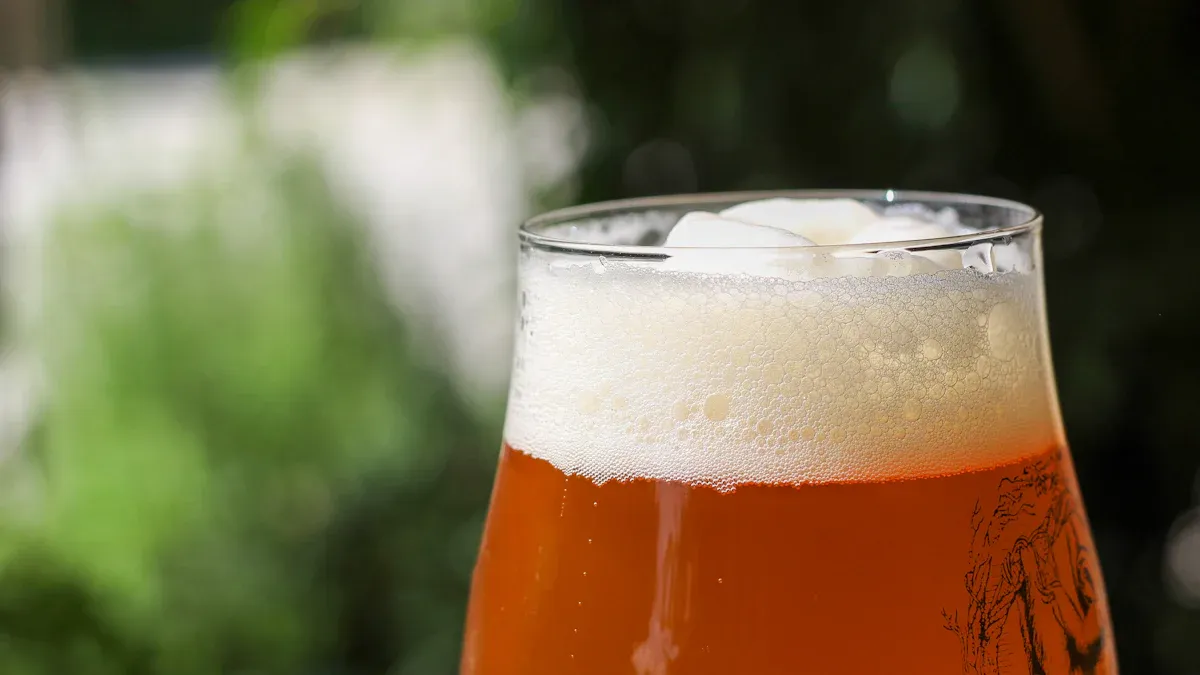
The 1-2-3 rule helps you manage your alcohol intake by setting clear limits. When you ask, "what is the 1/2/3 rule for alcohol?", you learn that it guides you to have no more than one drink per hour, two drinks per occasion, and three drinks per day. This 1-2-3 rule makes it easier to avoid drinking too much. You need to know what counts as a standard drink. Studies show that understanding standard drink sizes helps you track your alcohol use, set safe limits, and make better choices about drinking.
Key Takeaways
The 1-2-3 rule limits alcohol to one drink per hour, two drinks per occasion, and three drinks per day to help you drink safely.
Knowing what counts as a standard drink helps you track your alcohol and follow the rule more easily.
Taking at least three alcohol-free days each week gives your body a break and lowers health risks.
Use simple habits like drinking water between drinks and setting clear limits to stay in control at social events.
The rule helps reduce risks but does not remove all dangers; some people should avoid alcohol completely.
What is the 1/2/3 Rule for Alcohol?
![What is the 1/2/3 Rule for Alcohol?]()
The 1-2-3 rule gives you clear drinking guidelines to help you make safer choices about alcohol. When you ask, "what is the 1/2/3 rule for alcohol?", you learn that this rule sets limits on how much you should drink in a certain time. You follow three main steps: no more than one drink per hour, no more than two drinks per occasion, and no more than three drinks per day. Some health experts also suggest you take at least three alcohol-free days each week. This approach helps you avoid drinking too much and lowers your risk of health problems.
You might wonder what counts as a standard alcoholic drink. In the United States, the amount of pure alcohol in a drink matters most. The CDC says a standard alcoholic drink has 0.6 fluid ounces (14 grams) of pure alcohol. This amount is the same whether you drink beer, wine, or spirits. Here is a simple table to help you understand:
Beverage Type | Typical Serving Size | Alcohol by Volume (ABV) | Pure Alcohol Content |
Beer | 12 ounces | 5% | 0.6 fluid ounces (14 grams) |
Wine | 5 ounces | 12% | 0.6 fluid ounces (14 grams) |
Distilled Spirits | 1.5 ounces | 40% | 0.6 fluid ounces (14 grams) |
Knowing this helps you track your alcohol consumption and follow the 1-2-3 rule more easily.
Tip: The 1-2-3 rule is a guideline, not a guarantee of safety for everyone. Some people, such as those with certain health conditions or a history of addiction, should avoid alcohol completely.
1 Drink Per Hour
The first part of the 1-2-3 rule tells you to have no more than one drink per hour. Your body needs time to process alcohol. Drinking more than one drink in an hour can raise your blood alcohol concentration (BAC) quickly. When you keep to one drink per hour, you give your liver time to break down the alcohol. This helps you stay in control and lowers your risk of accidents or poor decisions.
2 Drinks Per Occasion
The second step in the 1-2-3 rule says you should not have more than two drinks in one occasion. When you ask, "what is the 1/2/3 rule for alcohol?", this part helps you avoid binge drinking. If you drink one or two drinks, your BAC usually stays in a lower range. You may feel relaxed or more social, but you do not reach the high levels that cause serious impairment. If you drink more than two drinks, your BAC can rise above 0.08%, which is the legal limit for driving in many places. Higher BAC levels can lead to poor judgment, loss of coordination, and even dangerous health effects.
3 Drinks Per Day
The last part of the 1-2-3 rule sets a daily limit. You should not have more than three drinks in one day. Drinking more than this can harm your health. Research shows that exceeding three drinks per day increases your risk for liver disease, high blood pressure, heart failure, and several types of cancer. You also face a higher chance of accidents, mental health problems, and addiction. U.S. guidelines recommend even lower limits for women—no more than one drink per day. For men, the recommended alcohol consumption is no more than two drinks per day. The 1-2-3 rule helps you stay below these limits.
Many health organizations also recommend you take at least three alcohol-free days each week. This gives your body a break and helps prevent dependence. You can see this advice in countries like Estonia, where national guidelines suggest at least three alcohol-free days for both men and women.
The 1-2-3 rule recommends at least 3 alcohol-free days per week.
It is supported by the National Institute on Alcohol.
The rule aims to promote safer drinking habits by limiting drinks per hour and per day, alongside alcohol-free days.
Encourages breaks in consumption to reduce health risks.
Note: Some people think they can save up drinks and have them all at once later in the week. This is a common misconception. The 1-2-3 rule works best when you spread out your drinks and avoid binge drinking.
When you follow the 1-2-3 rule, you set healthy limits for alcohol consumption. You protect your body and mind, and you lower your risk of harm. If you ever wonder, "what is the 1/2/3 rule for alcohol?", remember these simple steps and use them to guide your choices.
1-2-3 Rule in Practice
Pacing Alcohol Intake
You can use the 1-2-3 rule to help you make better choices about drinking. This rule helps you slow down how much you drink and keeps you from having too much. At a party or with friends, you might feel like you should drink more. The 1-2-3 rule gives you a simple plan to follow.
Here are some ways to use the 1-2-3 rule at parties or events:
Decide before you go how many drinks you will have, like just one for the night.
Drink water after each alcoholic drink to help you drink less.
Pick mocktails or other non-alcoholic drinks so you can still join in.
Write down what you drink each day in a journal. This helps you see when you drink more, like when you feel stressed or nervous.
Only drink on weekends or special days. You can skip alcohol during the week.
Try non-alcoholic beer or sparkling water if you want to fit in but not drink alcohol.
Make it normal to not drink unless it is a special time. This keeps your drinking low.
These habits help you stay in control and keep your drinking safe. You protect your health and can still have fun at social events.
When to Use the Rule
The 1-2-3 rule is best when you want to keep your drinking safe. Always use this rule if you need to drive, take medicine, or stay alert. The rule helps you keep your blood alcohol level low so your brain works well.
Here is a table that shows how the 1-2-3 rule helps you stay safe, especially when you drive or do important things:
Guideline Step | Recommendation | Purpose |
ZERO | No drinks when driving or doing safety-sensitive work | Stops any alcohol from making you unsafe while driving |
ONE | No more than one standard drink per hour | Keeps your blood alcohol level lower |
TWO | No more than two standard drinks per occasion | Helps you not drink too much at once |
THREE | Never exceed three standard drinks per occasion | Stops you from drinking so much that your brain is harmed |
You should also use the 1-2-3 rule if you take medicine that does not mix with alcohol or if you are pregnant. The rule helps you make safer choices and lowers your chance of getting hurt by alcohol. When you follow these steps, you keep your drinking healthy and take care of yourself.
Alcohol and Health
![Alcohol and Health]()
Benefits of Moderation
If you use the 1-2-3 rule, you set clear limits for drinking. This helps you not drink too much and keeps you safer. Some people think drinking a little can help your health. But new studies say even small amounts do not make you live longer or stop sickness. The World Health Organization and CDC both say no amount of alcohol is totally safe.
Note: Drinking less or not drinking at all is the best way to lower your health risks from alcohol.
Some people feel more relaxed or friendly after one or two drinks. The 1-2-3 rule helps you keep your drinking low. This makes it easier to stay in control and avoid accidents or bad choices. You also give your body time to break down alcohol, which protects your liver and brain.
Risks and Limitations
Even if you follow the 1-2-3 rule, alcohol can still be risky. Studies show that even moderate drinking can raise your risk for cancer, heart problems, and changes in your brain. The US Surgeon General says alcohol can cause cancer, even if you drink a little. Drinking a lot over time can hurt your brain, heart, and other organs.
Some people should not drink alcohol at all. These groups are:
Adolescents and anyone under the legal drinking age
Women who are pregnant or trying to get pregnant
People with certain health conditions, such as liver or kidney disease
Anyone taking medicine that interacts with alcohol
People recovering from alcohol use disorder
Adults who plan to drive or use machines
You should always ask your doctor if you are not sure about drinking and your health.
Different countries have their own rules for alcohol. The 1-2-3 rule matches US advice for moderate drinking, but other places use different numbers. For example, some countries count a standard drink as 8 to 20 grams of alcohol. Here is a table that compares the 1-2-3 rule to CDC guidelines:
Aspect | 1-2-3 Rule (US Coast Guard) | CDC Guidelines (US) |
Drinks per hour | No more than 1 standard drink | Not specifically defined |
Drinks per occasion | No more than 2 standard drinks | Not specifically defined |
Drinks per day | No more than 3 drinks | Women: up to 1/day; Men: up to 2/day |
Purpose | Behavioral guideline | Medical advisory for moderate drinking |
Remember: The 1-2-3 rule helps you manage alcohol, but it does not remove all risks. Always think about your own health and situation before you drink.
Applying the Rule
Tips for Moderation
You can make the 1-2-3 rule work for you by using simple strategies every day. Many people find it hard to limit alcohol, especially at parties or when feeling stressed. You can try these tips to help you stay on track:
Plan alcohol-free days each week to give your body a break.
Choose smaller drinks, like a bottle of beer instead of a pint, or pick drinks with less alcohol.
Drink water or a soft drink between alcoholic drinks to slow down your intake.
Avoid joining drinking rounds so you can control how much you drink.
Use smaller glasses at home and only drink with meals.
Set a clear limit before you start drinking and stick to it.
Join campaigns like Dry January or Sober Spring for extra support.
Tip: If you feel pressure to drink at social events, bring your own alcohol-free drink or let friends know you are cutting back.
You may face barriers, such as social pressure or easy access to alcohol. Stress can also make it harder to follow the 1-2-3 rule. Remember, you can always say no or choose a non-alcoholic option.
Tracking Habits
Tracking your alcohol habits helps you see patterns and make better choices. Many apps and tools can help you log your drinks and set goals. Here are some ways to track your alcohol use:
Use apps like MyDrinkaware, DrinkControl, or Drinks Meter to log drinks, set goals, and get feedback.
Keep a diary or journal to write down what you drink each day.
Try printable tracker cards from groups like Rethinking Drinking.
Use habit-tracking apps such as Streaks or I Am Sober for daily reminders.
Review your progress each week and look for times when you drink more, like during stress or special events.
Ask friends, family, or a support group to help you stay accountable.
You can personalize the 1-2-3 rule to fit your health and lifestyle. Some people need to avoid alcohol because of health problems or medicine. Others may want to drink less during busy weeks or after a stressful day. You can talk to your doctor or a counselor for advice that fits your needs. By tracking your habits and making small changes, you can keep alcohol from taking over your life.
You can follow the 1-2-3 rule to help you drink less alcohol. This rule helps you set clear limits and keeps you healthier. Some studies say drinking a little might help your heart. But even small amounts can raise your risk for cancer and hurt your brain.
Many experts say you should keep track of your drinking. You should also learn what makes you want to drink and take days off from alcohol.
Support groups and resources like Moderation Management and the NIAAA can help you make safer choices.
It is important to be careful and know your own limits. If you worry about alcohol, talk to a doctor or nurse.
FAQ
What if you drink more than the 1-2-3 rule suggests?
You increase your risk for health problems and accidents. Try to return to the rule next time. If you often go over the limit, talk to a doctor or counselor for help.
Can you save up your drinks for the weekend?
No, you should not save up drinks. Drinking many drinks at once is called binge drinking. This can harm your body and mind more than spreading drinks out.
Does the 1-2-3 rule work for everyone?
The rule helps most adults drink less. Some people should not drink at all, like those who are pregnant, underage, or taking certain medicines. Always check with your doctor.
What counts as a standard drink?
A standard drink in the U.S. has 0.6 ounces of pure alcohol. This equals 12 ounces of beer, 5 ounces of wine, or 1.5 ounces of spirits.
How can you track your drinks easily?
Use a phone app to log each drink.
Write down your drinks in a notebook.
Ask a friend to help you remember your limit.
Tracking helps you see your habits and make safer choices.






























